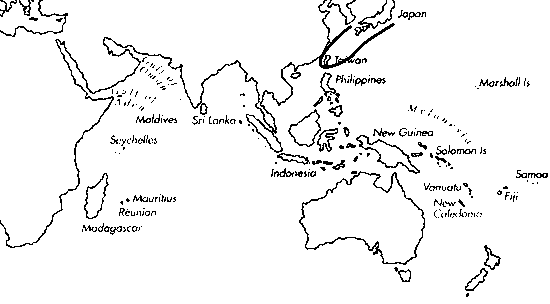Range: Japan and Taiwan.
Description: Moderately large to large, moderately solid to solid. Last whorl usually conical or ventricosely conical; outline variably convex at adapical third to half, straight below; left side often slightly concave toward base. Shoulder broadly carinate. Spire of moderate height and stepped, outline straight to slightly concave. Larval shell of 3 whorls, maximum diameter 1.1 mm. Postnuclear spire whorls carinate, first 4-7 also tuberculate. Teleoconch sutural ramps concave, with densely spaced radial threads, sometimes with numerous spiral striae in late whorls. Last whorl with punctate or axially striate spiral grooves from base to centre, separating narrow ribbons or ribs anteriorly and broad ribbons posteriorly.
| Shell Morphometry | ||
|---|---|---|
| L | 60-129 mm | |
| RW | 0.14-0.60 g/mm | |
| (L 60-111 mm) | ||
| RD | 0.49-0.56 | |
| PMD | 0.82-0.89 | |
| RSH | 0.13-0.20 | |
Ground colour white, sometimes bluish grey. Last whorl with sparse brown axial markings, mainly above centre, sometimes forming an interrupted spiral band. Spiral rows of widely spaced brown dots occur in some specimens. Larval whorls white. Teleoconch sutural ramps with very sparse brown radial markings, primarily in early whorls. Aperture white.
Periostracum olive to brown, rather thin, slightly translucent to opaque, with fine axial ridges that are strong on sutural ramps. Operculum long, elongately ovate, smooth at edges.
Habitat and Habits: In 50-400 m; reported from mud bottom.
Discussion: C. sieboldii resembles C. tribblei, C. lenavati, C. sugimotonis, C. ione, C. teramachii, and C. boholensis. C. tribblei has a similar colour pattem but differs in its more solid shell in specimens of same size (RW 0.30-1.01), the strong spiral grooves on its sutural ramps, and in its lower spire (RSH 0.04-0.13) that is not stepped. C. lenavati also has a similar colour pattern but its last whorl is distinctly broader (RD 0.56-0.71), its spire lower (RSH 0.02-0.13) and not carinate, and its sutural ramps have distinct spiral grooves. C. sugimotonis has a more solid shell, broader last whorl (RD 0.54-0.62), lower spire (RSH 0.02-0.1 1), and pronounced spiral grooves on its sutural ramps. C. ione does not become as large (to 76 mm), has a broader and slightly pyriform last whorl (RD 0.55-0.64), and bears regularly set brown dots at the outer margins of its sutural ramps. C. teramachii differs in the absence of any brown pattem elements, the distinct spiral grooves on the sutural ramps, and in the distinctive serrated operculum. For comparison with C. boholensis, see the Discussion of that species. Azuma (1961) distinguished C. petricosus from C. sieboldii by the absence of any pattern elements, its "very solid shell and its different radular teeth. However, the conchological differences largely fall within the range of variation observed in C. sieboldii, and Azuma did not discuss the radular differences in detail. Therefore we provisionally assign C. petricosus to C. sieboldii.

C. sieboldii range map
This section contains verbatim reproductions of the accounts of 316 species of Conus from the Indo-Pacific region, from Manual of the Living Conidae, by Röckel, Korn and Kohn (1995). They are reproduced with the kind permission of the present publisher, Conchbooks.
All plates and figures referred to in the text are also in Röckel, Korn & Kohn, 1995. Manual of the Living Conidae Vol. 1: Indo-Pacific Region.
The range maps have been modified so that each species account has it own map, rather than one map that showed the ranges of several species in the original work. This was necessary because each species account is on a separate page on the website and not confined to the order of accounts in the book.